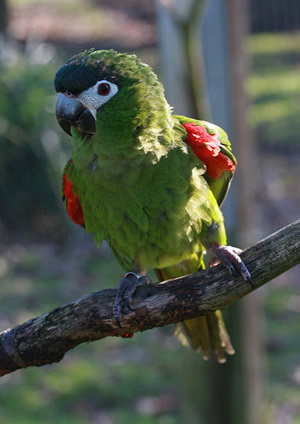Summary
Macaws are small to large, often colorful New World parrots. Of the many different Psittacidae (true parrots) genera, six are classified as macaws: Ara, Anodorhynchus, Cyanopsitta, Primolius, Orthopsittaca, and Diopsittaca. Previously, the members of the genus Primolius were placed in Propyrrhura, but the former is correct as per ICZN rules. Macaws are native to Mexico, Central America, South America, and formerly the Caribbean. Most species are associated with forest, especially rainforest, but others prefer woodland or savanna-like habitats.
Large, dark (usually black) beaks, and relatively hairless, light colored, medial facial (facial patch) areas distinguish macaws. Sometimes the facial patch is smaller in some species, and limited to a yellow patch around the eyes and a second patch near the base of the beak in the members of the genus Anodorhynchus, or Hyacinth Macaw. It has been documented that a Macaw's facial feathers are unique as a human fingerprint.
Some of the macaw species are popularly known for their impressive size. The largest parrot in length and wingspan is the Hyacinth Macaw. The heaviest macaw is the Buffon's, although the heaviest parrot is the flightless Kakapo. While still relatively large parrots, the macaws of the genera Cyanopsitta, Orthopsittaca and Primolius are significantly smaller than the members of Anodorhynchus and Ara. The smallest member of the family, the Red-shouldered Macaw, is no larger than some parakeets of the genus Aratinga.
Macaws, like other parrots, as well as toucans and woodpeckers, are zygodactyl, having their first and fourth toe pointing backwards.
Macaws eat nuts, seeds, fruit, and sometimes insects. They also gnaw and chew on various objects. They show a large amount of intelligence in their behavior and require constant intellectual stimulation to satisfy their innate curiosity. They often learn tricks easily.
Macaws have been said to live for up to 100 years; however, an average of 50 years is probably more accurate. The larger macaws may live up to 65 years. They are monogamous and mate for life. In captivity unmated macaws will bond primarily with one person – their keeper, and can often be quite affectionate and cuddly. Pet macaws thrive on frequent interaction and attention from their owners, and a lack of this can lead to their mental and physical suffering.
Other sub-bondings also take place and most macaws that are subjected to non-aggressive behavior will trust most humans, and can be handled even by strangers if someone familiar is also alongside.
Captive pet macaws sometimes display difficult behavior, the most common being biting, screaming, and feather-plucking. Feather-plucking does not normally occur in the wild, strongly suggesting that it is the result of a neurosis related to life in captivity, though some sources suggest other causes such as inbreeding in captive populations, food allergies, and dry skin (most of these birds are adapted to humid climates).
Most pet macaws had ancestors living in the wild just two to four generations ago, and are not truly domesticated by any reasonable definition. (This is unlike, for example, dogs; some estimates put the domestication of dogs as far back as 40,000 years ago.) They are, however, quite social and adaptable birds.
All species of macaws have very powerful, large beaks and large macaws are capable of destroying household furnishings and can potentially cause considerable harm to both children and adults. They tend to be loud: in the wild their voices need to carry over long distances. This makes macaws very demanding birds to keep as a household pet. Additional complications arise from the intelligence levels of macaws and their negative responses to stimuli people may use on domestic pets, such as punishment.
A common trend in recent years is hybridising macaws for the pet trade. Hybrids are typical macaws, with the only difference from true species being their genetics and their colors. Male offspring tend to take on the traits of the mother, and the females take the traits of the father. As for their temperament and behavior, they seem to inherit traits of both parents.
Aviculturists have reported an over abundance of female blue and gold macaws in captivity, which differs from the general rule with captive macaws and other parrots, where the males are more abundant. This would explain why the blue and gold is the most commonly hybridised macaw, and why the hybridising trend took hold among macaws. Common macaw hybrids include Harlequins (Ara ararauna x chloroptera) and Catalinas (known as Rainbows in Australia, A. ararauna x macao).
As a number of species of macaws are endangered, it would be beneficial to maintain pure breeding stock of captive macaws to ensure species preservation. Hybridizing dilutes the available gene pool and could hasten a species extinction.
Macaws are known to eat clay, which is believed to work as an antidote to the poisonous seeds they eat. The chemicals in the clay mix with the poison allowing it to pass through the bird's digestive system without harming the bird.
Large Macaws require a large amount of room and thus the cage a single bird occupies should be as large as possible, 36 inches wide x 36 inches deep x 60 inches high, or larger. They need ample amounts of room to prevent the muscles in their wings from atrophying as well as plenty of room to play, exercise in, and spread their wings. The bars of the cage should be no larger than 1 inch apart and should be made of durable metal. It should not have parts that contain lead or zinc, including paint on the bars. Cage cleaning and hygiene are important, Many cages have a grate covering the base to separate the bird from its droppings. The cage should be placed in an area that is off the floor, well-lit, and of a consistent temperature. Perches are acceptable and recommended; perches of varied materials and size are required to keep feet healthy. Stands placed strategicly around the house are important as an additional place to hang out and be part of the family. A spray bottle of lukewarm water can be used to bathe the bird. (All macaws typically like water and will also respond happily to an outing in the kitchen sink as well or spray down in the shower.)






